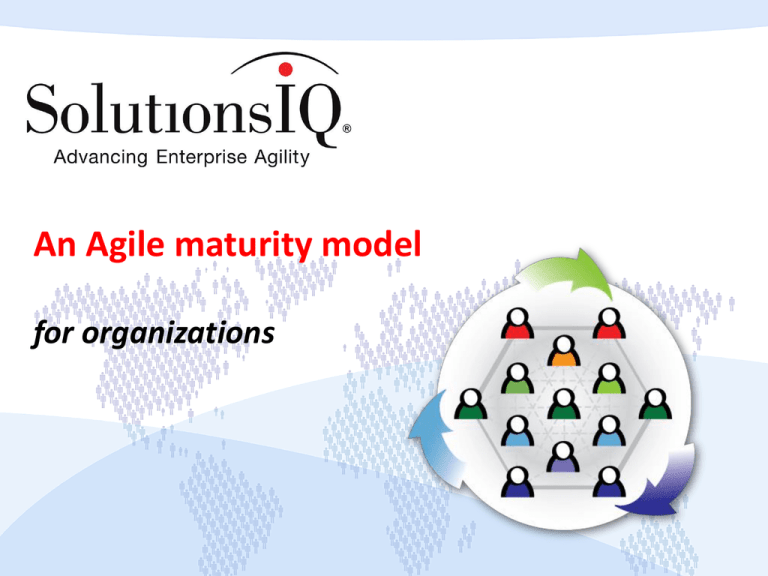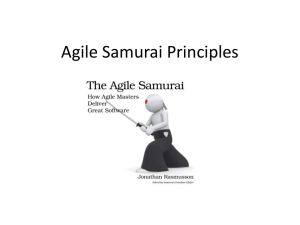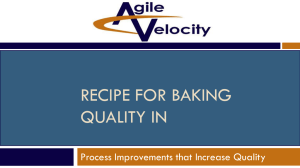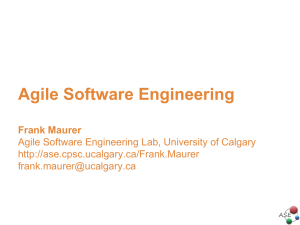
An Agile maturity model
for organizations
Introduction to maturity
models
Copyright © 2013 SolutionsIQ. All rights reserved.
What is a maturity model?
Copyright © 2013 SolutionsIQ. All rights reserved.
Why a maturity model?
Understand what
future capability is
possible
Understand current
capability
Copyright © 2013 SolutionsIQ. All rights reserved.
Understand what is
needed to achieve higher
maturity
Features of a strong maturity model
Easy to observe
Broad and consistent
Measured
objectively
Copyright © 2013 SolutionsIQ. All rights reserved.
Types of maturity models
Person
Team
Process
Organization
Copyright © 2013 SolutionsIQ. All rights reserved.
Person maturity models
Copyright © 2013 SolutionsIQ. All rights reserved.
Team maturity model
Tuckman model
Copyright © 2013 SolutionsIQ. All rights reserved.
Process maturity model
CMMI
Copyright © 2013 SolutionsIQ. All rights reserved.
Agile maturity models
Copyright © 2013 SolutionsIQ. All rights reserved.
Agile incorporates CMMI features
Copyright © 2013 SolutionsIQ. All rights reserved.
Agile is people-centric (not process-centric)
“Individuals and interactions over processes and tools”
Copyright © 2013 SolutionsIQ. All rights reserved.
Agile maturity models
Person
Copyright © 2013 SolutionsIQ. All rights reserved.
Team
Organization
The Agile maturity for
organizations
Copyright © 2013 SolutionsIQ. All rights reserved.
Agile maturity model levels
Copyright © 2013 SolutionsIQ. All rights reserved.
Agile maturity model coverage
Level
Coverage
The Agile enterprise
0 to 100%
Portfolio management
0 to 100%
Program management
0 to 100%
Teams
0 to 100%
Copyright © 2013 SolutionsIQ. All rights reserved.
Agile maturity model types of work
The value stream
Different types of work
Copyright © 2013 SolutionsIQ. All rights reserved.
The model
Copyright © 2013 SolutionsIQ. All rights reserved.
Level 1: Project focus
Copyright © 2013 SolutionsIQ. All rights reserved.
Level 1: Project focus (pre-agile)
Work group
Work group
Resource pool
Work group
Copyright © 2013 SolutionsIQ. All rights reserved.
Level 1: Individual unit of production
Workgroup capacity is increased by
adding “resources”
Person is the unit of
production
Resource pool
Copyright © 2013 SolutionsIQ. All rights reserved.
Work group
Level 1: Work group cost model
Workload
waste
Start up
Copyright © 2013 SolutionsIQ. All rights reserved.
Completed Work
Shut
down
waste
Level 1: The workgroup
• Projects are cost centers
• Individuals are allocated to
projects
• Temporary work groups
• Individuals are costs
• Individuals are “standard parts”
Value = lower unit labor cost
Copyright © 2013 SolutionsIQ. All rights reserved.
Level 2: Agile teams
Copyright © 2013 SolutionsIQ. All rights reserved.
Level 2: Teams vs. workgroups
Work group
Copyright © 2013 SolutionsIQ. All rights reserved.
Agile team
Level 2: Persistent teams
Re-assignment
Re-assignment
Copyright © 2013 SolutionsIQ. All rights reserved.
Level 2: Team is unit of production
Copyright © 2013 SolutionsIQ. All rights reserved.
Level 2: Agile team cost model
Workload
Minimal
Start up
Completed Work
Minimal shut
down
Shorter time to complete
Copyright © 2013 SolutionsIQ. All rights reserved.
Level 2: Agile team summary
New capabilities:
• increased throughput
• quicker response
• higher quality
Value = Return on team investment
Copyright © 2013 SolutionsIQ. All rights reserved.
Level 3: Agile program
management
Copyright © 2013 SolutionsIQ. All rights reserved.
Level 3: Agile program management
Copyright © 2013 SolutionsIQ. All rights reserved.
Level 3: Agile program management
New capabilities:
• Multi-project integration
• Early & frequent release
• Features by business value
• Start fast/fail fast
Value = early & frequent release
(reduced cost of delay)
Copyright © 2013 SolutionsIQ. All rights reserved.
Level 4: Agile portfolio
management
Copyright © 2013 SolutionsIQ. All rights reserved.
Level 4: Agile portfolio
Copyright © 2013 SolutionsIQ. All rights reserved.
Level 4: Agile portfolio management
New capabilities:
• Investment planning
• Incremental funding
• Governance by risk type
Value = overall portfolio return &
market responsiveness
Copyright © 2013 SolutionsIQ. All rights reserved.
Level 5: The Agile
enterprise
Copyright © 2013 SolutionsIQ. All rights reserved.
Level 5: The Agile enterprise
Copyright © 2013 SolutionsIQ. All rights reserved.
Level 5: The Agile enterprise
New capabilities:
• New market penetration
• Collaborative corporate
culture
• Distributed leadership
• Scalable operations
Value = Brand & enterprise equity,
internal alignment, employee satisfaction,
fixed-cost reduction
Copyright © 2013 SolutionsIQ. All rights reserved.
Questions
Copyright © 2013 SolutionsIQ. All rights reserved.









